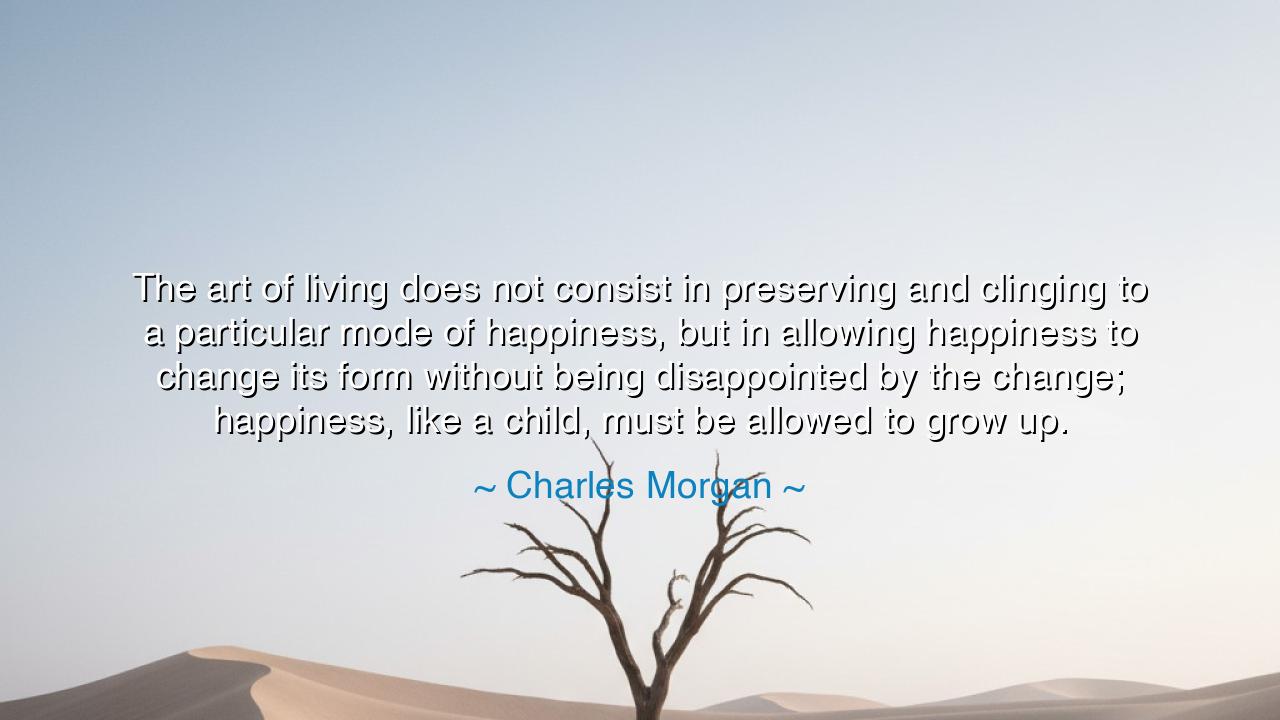
The art of living does not consist in preserving and clinging to
The art of living does not consist in preserving and clinging to a particular mode of happiness, but in allowing happiness to change its form without being disappointed by the change; happiness, like a child, must be allowed to grow up.






When Charles Morgan wrote, “The art of living does not consist in preserving and clinging to a particular mode of happiness, but in allowing happiness to change its form without being disappointed by the change; happiness, like a child, must be allowed to grow up,” he offered a truth of deep and enduring wisdom—a truth that whispers through the corridors of every human life. His words speak to the impermanence of joy, to the flowing river of existence that never allows the same waters to be touched twice. In his vision, happiness is not a fixed possession, nor a single emotion to be captured and kept, but a living, evolving force, meant to change as we change. The one who clings to a single kind of happiness, he warns, will suffer; the one who lets it grow and transform will find peace.
The origin of Morgan’s thought lies in his lifelong meditation on art, love, and the human spirit. A novelist and essayist of the early twentieth century, he lived through the shadowed years of war and the uneasy calm that followed. He saw how people sought to hold onto the happiness of earlier days—how they longed for youth, for certainty, for the familiar light that once guided them. Yet time, that silent sculptor, reshapes all things. Morgan understood that to live wisely is to live with grace amid change, to let each season of happiness ripen, fade, and give birth to the next. His words call us to a higher maturity: to cherish joy not as a fragile treasure to be protected, but as a companion that must evolve alongside us.
This lesson is as old as time. The ancient philosophers of both East and West taught that attachment—the desperate clinging to one state of being—is the root of suffering. The Buddha likened life to a wheel in motion, forever turning; to resist its movement is to be crushed beneath it. Likewise, the Greek sage Heraclitus declared that “everything flows, and nothing stands still.” To Morgan, happiness itself is part of that flow. The laughter of youth matures into the quiet contentment of middle age, and later into the serene gratitude of old age. Each stage is beautiful in its own right, yet only those who let go of the past can receive the gift of the present. Thus, the art of living is not mastery over time, but harmony with it.
History, too, offers us a mirror of this truth. Consider the life of Helen Keller, who was cast into darkness and silence as a child but discovered, through courage and faith, a happiness greater than most ever know. Her early joy—the joy of touch, of learning words, of unlocking communication—did not last unchanged. As she grew, that happiness transformed into purpose, into the joy of serving others, of writing, of advocating for the blind. She did not cling to the happiness of her youth; she allowed it to grow up, as Morgan wrote. Her life became a symphony of changing joys, proof that happiness can evolve and deepen even in the face of adversity. In her, we see that true joy is not bound by circumstance but shaped by the soul’s willingness to grow.
The danger of clinging, Morgan implies, lies in disappointment. When we try to preserve a moment of happiness—as lovers try to hold the first flush of passion, or parents long for their children to remain young—we invite sorrow. Life moves forward, and happiness, like a child, cannot stay small forever. It must change form: from passion to companionship, from achievement to reflection, from ambition to peace. The one who resists this change will grieve what was lost instead of celebrating what has become. But the one who accepts that happiness is alive—that it grows as we do—will find a deeper, more resilient joy, one that endures even when its form is unrecognizable.
Morgan’s image of happiness as a child is profoundly tender. A child who is loved must be allowed to grow, to stumble, to change; otherwise, love becomes possession, and growth becomes suffocation. So it is with joy. When we imprison it in memory or fear, it withers. But when we give it freedom—when we allow it to take new forms—we remain young in spirit, no matter our years. This is the essence of wisdom in living: not to chase the past or fear the future, but to meet each new shape of happiness with an open heart.
So, my children of the present age, remember this teaching: do not cling to joy, but cultivate it. Let your happiness evolve as the seasons do. When life changes, do not mourn what was, but look for what new form joy has taken. If you are young, rejoice in your energy; if you are old, rejoice in your understanding. When love matures, let it do so gracefully; when passions fade, let peace take their place. For as Charles Morgan teaches, the art of living is not in holding still but in flowing freely—allowing happiness to grow, to age, and to transform without bitterness. In this acceptance lies the secret harmony of life: a happiness that is not trapped in time, but carried forward like a flame, changing shape but never dying.






AAdministratorAdministrator
Welcome, honored guests. Please leave a comment, we will respond soon